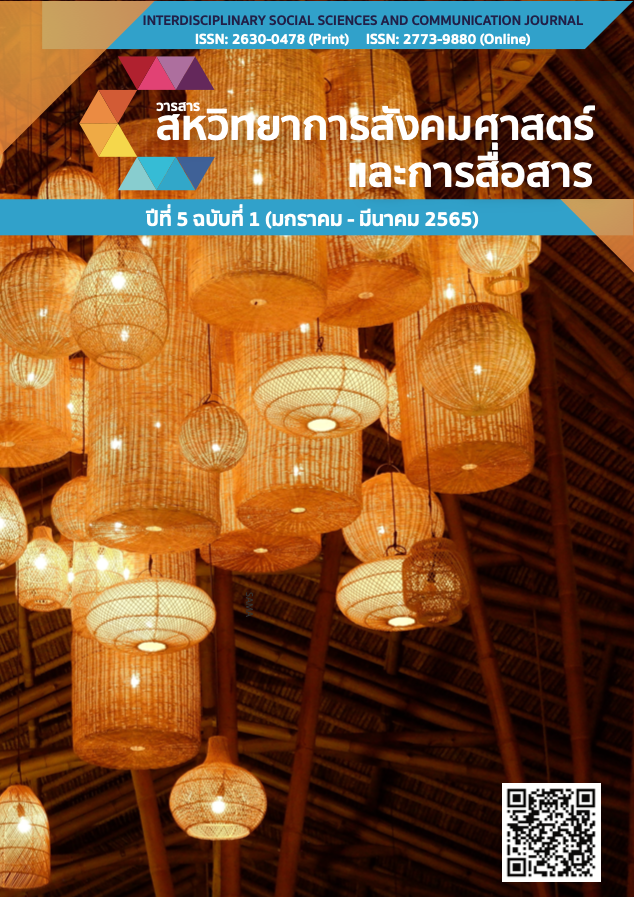การออกแบบสื่อธุรกิจสำหรับตู้รีฟิลสินค้าจากธรรมชาติ
Main Article Content
บทคัดย่อ
การออกแบบสื่อธุรกิจสำหรับตู้รีฟิลสินค้าจากธรรมชาติ มีวัตถุประสงค์ 1.เพื่อศึกษาค้นคว้าการสร้างแบรนด์ธุรกิจสำหรับตู้รีฟิลสินค้าอุปโภคจากธรรมชาติ 2.เพื่อการสื่อสารแบรนด์และประชาสัมพันธ์ธุรกิจสำหรับตู้รีฟิลสินค้าอุปโภคจากธรรมชาติ ซึ่งในการวิจัยครั้งนี้ผู้วิจัยได้ใช้วิธีการวิจัยแบบการวิจัยและพัฒนาแบ่งออกเป็น 4 ขั้นตอน ขั้นตอนที่หนึ่งเป็นขั้นตอนการศึกษาและวิเคราะห์การออกแบบและการสรรค์สร้างแบรนด์ธุรกิจจากงานวิจัยที่เกี่ยวข้องรวมถึงการสำรวจพฤติกรรมและปัจจัยที่มีผลต่อการตัดสินใจของผู้บริโภคในการเลือกซื้อสินค้าจากธรรมชาติ ผลพบว่า ปัจจัยทางด้านภาพลักษณ์และสื่อประชาสัมพันธ์งานออกแบบของผลิตภัณฑ์จากธรรมชาติ ที่กลุ่มเป้าหมายให้ความสนใจ และนำร่างแบบตู้รีฟิลสินค้าอุปโภคจากธรรมชาติที่วิเคราะห์จากความต้องการจากกลุ่มเป้าหมาย ทั้งหมด 6 แบบ 3 คอนเซ็ปต์ 1.Natural Harmony ให้ความรู้สึกถึงธรรมชาติ 2.Secret Story น่าค้นหาเข้าถึงเรื่องราวแหล่งที่มาและแบบที่ 3.Modern Cozy ทันสมัยใส่ใจสิ่งแวดล้อม ขั้นตอนที่สามผู้วิจัยนำแบบร่างที่ออกแบบไปขอคำแนะนำจากผู้เชี่ยวชาญด้านการสร้างแบรนด์และการออกแบบผลิตภัณฑ์ จำนวน 3 ท่าน ผลพบว่าผู้เชี่ยวชาญทั้งสามท่านเห็นตรงกันและสนใจแบบ A2 ผู้ทำวิจัยจึงต้องปรับรูปแบบฐานของตัวตู้ในแบบ A2 ให้ถูกหลักของการออกแบบผลิตภัณฑ์มากขึ้นและพัฒนาต้นแบบรีฟิลสินค้าจากธรรมชาติตามความต้องการของกลุ่มเป้าหมาย
Article Details

อนุญาตภายใต้เงื่อนไข Creative Commons Attribution-NonCommercial-NoDerivatives 4.0 International License.
** ข้อความ ข้อคิดเห็น หรือข้อค้นพบ ในวารสารสหวิทยาการสังคมศาสตร์และการสื่อสารเป็นของผู้เขียน ซึ่งจะต้องรับผิดชอบต่อผลทางกฎหมายใด ๆ ที่อาจเกิดขึ้นจากบทความและงานวิจัยนั้น ๆ โดยมิใช่ความรับผิดชอบของคณะนิเทศศาสตร์ มหาวิทยาลัยราชภัฏรำไพพรรณี **
เอกสารอ้างอิง
ศรีกัญญา มงคลศิริ. (2547). Brand Management. กรุงเทพฯ: เลิฟ แอนด์ เลิฟ.
ศิริวรรณ เสรีรัตน์. (2539). รายงานการวิจัยเรื่องการตลาดเพื่อสิ่งแวดล้อมในทัศนะของนิสิต/นักศึกษาที่กำลังศึกษาหลักสูตรบริหารธุรกิจมหาบัณฑิตในสถาบันอุดมศึกษาในสังกัด กรุงเทพมหานครและปริมณฑล.
ศูนย์วิจัยกสิกรไทย. (2562). SME จับเทรนด์รักษ์โลก เร่งสร้างเม็ดเงิน. สืบค้นจาก https://kasikornbank.com/th/business/sme/KSMEKnowledge/article/KSMEAnalysis/Documents/GreenBusiness.pdf
อนุรักษ์ ปิ่นทอง. (2554). อุตสาหกรรมผู้ร้ายในคราบนักบุญ. สืบค้นจาก http://ecologyindustrypinthong.blogspot.com/
Edward O Wilson. (1984). Biophilia. Retrieved from
https://www.hup.harvard.edu/catalog.php?isbn=9780674074422&content=reviews
NT. (2018). Taro Yamane : Determination of Population Groups for Research. Retrieved from https://greedisgoods.com/taro-yamane/.[in Thai]
Oliver Heath. (2018). Creating Positive Spaces. Retrieved from http://interfaceinc.scene7.com/is/content/InterfaceInc/Interface/EMEA/eCatalogs/Brochures/Community%20Design%20Guide/English/ec_eu-communitydesignguide-en.pdf
Stephen Kellert. (2017). The Practice of Biophilic Design. Retrieved from https://www.researchgate.net/publication/321959928_The_Practice_of_Biophilic_Design


